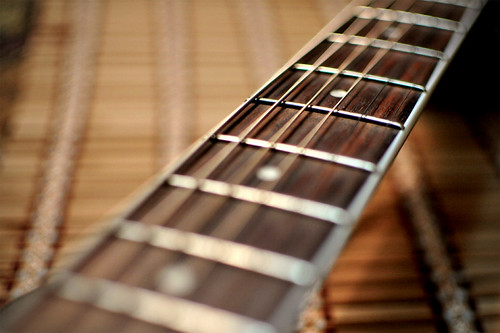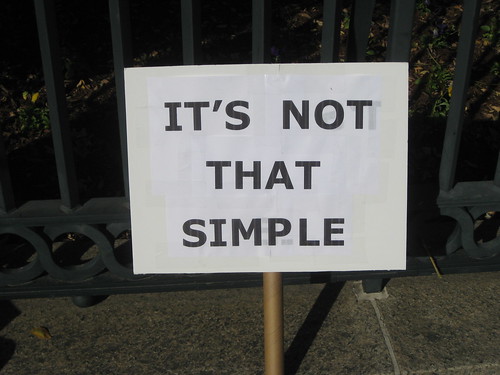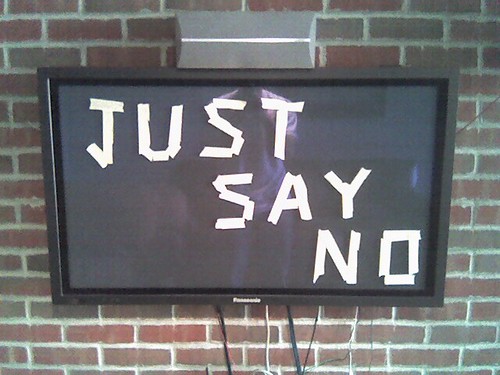 We are all faced with an age-old dilemma – getting lost in the distractions of life. It can feel like time is slipping between our fingers, and it can be incredibly challenging to simply remain “present” and be “in the moment”.
We are all faced with an age-old dilemma – getting lost in the distractions of life. It can feel like time is slipping between our fingers, and it can be incredibly challenging to simply remain “present” and be “in the moment”.
There are also some things that have the incredible ability to bring us back to that sweet spot in time, bring us back to the here and now, bring us back to the purity of the moment.
For me, this always happens when I pick up my guitar. There is something magical that happens when my fingers glide around those six strings.
 On the heels of a post on gurus, I found myself pondering the question of complexity – a hallmark of gurus.
On the heels of a post on gurus, I found myself pondering the question of complexity – a hallmark of gurus.
Many clinicians in health care wittingly (and unwittingly) make clinical scenarios more complex. They add layers of unnecessary complexity for the patient (and for other clinicians). It starts the moment they talk to patients in medical-speak. This is not done because it fosters a better learning experience for the patient. Hey, the more syllables you use, the smarter you sound, right? And if the solution is more complex, it just has to be better, no?
With that said, I ask you – when has added complexity ever made a situation (or solution) any better? We can turn to Albert Einstein – the father of modern physics – to shed some light on the problems of complexity in health care.
 Health and health care are chock full of systems and approaches that have both empirical and arbitrary foundations. They are typically based on the beliefs and anecdotes of a “guru”. With any guru comes a flock of disciples that espouse the earth-shattering wisdom of their guru.
Health and health care are chock full of systems and approaches that have both empirical and arbitrary foundations. They are typically based on the beliefs and anecdotes of a “guru”. With any guru comes a flock of disciples that espouse the earth-shattering wisdom of their guru.
Something oftentimes gets a little confused in the process: the guru and their methods become more important than the patients themselves.
Well, I would suggest one important reminder today: It’s not about you, oh mighty guru.
Health and health care are all about the patient. With that said, these domains don’t need any more gurus. There are more than enough snake oil salesman to go around. What we need are true science-based medicine and patient-focused approaches that implement competent self care strategies, and not just more lip service.
 It never ceases to amaze me. I go away for a brief vacation, and what happens? All kinds of crazy stuff takes place the world over.
It never ceases to amaze me. I go away for a brief vacation, and what happens? All kinds of crazy stuff takes place the world over.
Who was I to think that anyone would listen to my requests? I thought I had made it perfectly clear to the powers-that-be that everything was supposed to remain calm until I returned to Austin. But, no, that was not the case.
It would be asking a lot for the world to ease up on it’s global rhubarb production. With that said, I bring you a plethora of fine rhubarb - welcome to episode 48.
 I had the opportunity to attend the USA Track and Field SW Regional Masters Championship last month. I was there to consult with athletes and coaches on training- and injury-related issues. I always enjoy interacting with athletes at this level, given the range of ages and the broad variety of training backgrounds.
I had the opportunity to attend the USA Track and Field SW Regional Masters Championship last month. I was there to consult with athletes and coaches on training- and injury-related issues. I always enjoy interacting with athletes at this level, given the range of ages and the broad variety of training backgrounds.
There is a consistent theme throughout the masters athletics population: most have sustained training injuries, and a large percentage are continuing to train or compete with them. But what is perhaps more troubling is the perception of what is acceptable should an injury occur – especially regarding the time frame for recovery and the treatments to be utilized in the process.
Sadly, the accepted standard for injury recovery these days is a little disconcerting.
 Back in the day, I can remember going back to school in the fall and the teacher asking us to stand up and tell the class what we did on our summer vacation. Some kids would come back to school with great tales of adventure and travel. Others might have told their stories of camp. Many just tried to avoid getting in trouble in their own backyard.
Back in the day, I can remember going back to school in the fall and the teacher asking us to stand up and tell the class what we did on our summer vacation. Some kids would come back to school with great tales of adventure and travel. Others might have told their stories of camp. Many just tried to avoid getting in trouble in their own backyard.
One thing that we never had to do was tell the class something that we learned in the process. It was just about the “stuff” we did. This year, I am finally doing it a little differently. Here are seven affirmations from this year’s summer vacation.
 They have become the bane of our endurance training existence. Those incessant beep, beep, beeps as they pass me on the trail drive me crazy.
They have become the bane of our endurance training existence. Those incessant beep, beep, beeps as they pass me on the trail drive me crazy.
The heart rate monitor.
If you have been sedentary, are unfamiliar with exercise, or have no understanding of physical exertion, then the use of a heart rate monitor might prove helpful. Let’s allow you to have a 3 month window to use it to help establish a relationship between exertion and self-awareness during activity.
Then sell it on Craigslist. And get on with training.
You mean it’s not the gold standard to my endurance training success?
 "Running Injuries: Etiology And Recovery- Based Treatment" (co-author Bridget Clark, PT) appears in the third edition and fourth editions of "Clinical Orthopaedic Rehabilitation: A Team Approach" by Charles Giangarra, MD and Robert C. Manske, PT.
"Running Injuries: Etiology And Recovery- Based Treatment" (co-author Bridget Clark, PT) appears in the third edition and fourth editions of "Clinical Orthopaedic Rehabilitation: A Team Approach" by Charles Giangarra, MD and Robert C. Manske, PT.
 Allan Besselink, PT, DPT, Ph.D., Dip.MDT has a unique voice in the world of sports, education, and health care. Read more about Allan here.
Allan Besselink, PT, DPT, Ph.D., Dip.MDT has a unique voice in the world of sports, education, and health care. Read more about Allan here.
 Top 5 finalist in three categories: "Best Overall Blog", "Best PT Blog" and "Best Advocacy Blog".
Top 5 finalist in three categories: "Best Overall Blog", "Best PT Blog" and "Best Advocacy Blog".